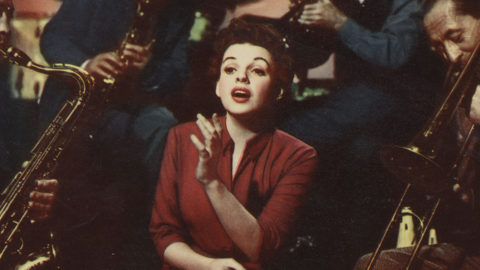In Memoriam: Stuart Gordon
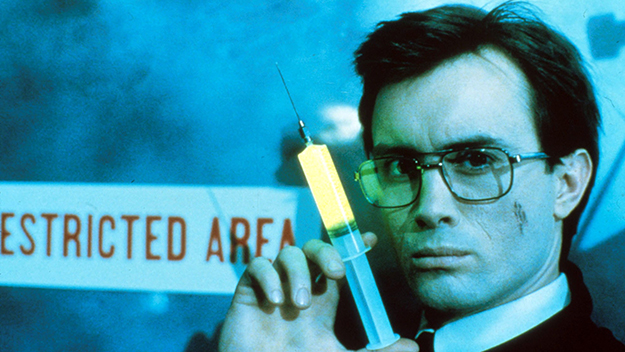
Re-Animator (Stuart Gordon, 1985)
During the height of the splatter film craze of the 1980s, Stuart Gordon’s seminal 1985 horror film, Re-Animator, based on the work of H.P. Lovecraft, was something different. While many horror films of the period were presenting a fairly “paint by numbers” exercise in stalking and killing, with violent on screen death as the ultimate, grim thrill offered up to viewers, Gordon’s erudite and assured first film squirmed with a playfully anarchic psycho-sexual black comedy. In Re-Animator, the human body, mutilated, mangled, and wildly desanctified, became the site of a dark, taboo-shattering slapstick, wherein, as the film’s poster famously promised, “Death is Just the Beginning…”
Gordon, who died last week, began his commitment to provocative art not in the film industry but in Chicago’s avant-garde theater. In the late 1960s, Gordon entered the theater department at University of Wisconsin. There, he would stage several shocking productions, including a version of Peter Pan inspired by his own participation in the 1968 riots at the Democratic National Convention. The production, which cast Peter and the lost boys as hippies and Captain Hook as Mayor Daley, left the original work largely intact. The trip to Neverland however, was reimagined as a nude dance sequence, resulting in an obscenity charge for Gordon and his wife, Carolyn Purdy-Gordon.
The couple would go on to form the pioneering Organic Theater Company, staging and premiering works such as David Mamet’s Sexual Perversity in Chicago and giving future stars Joe Mantegna and Dennis Franz their start. The boundary-pushing politics of the avant-garde theater of the 1960s continued to inform Gordon’s work throughout his career, as the filmmaker told Cineaste in a 2009 interview: “It’s just something that’s been part of my art ever since.” Actor Jeffrey Combs, a frequent collaborator, attested to this when I spoke with him after the news about Gordon broke: “He was always a bit of a Don Quixote, charging at windmills, battles just for the sake of ‘if not me, it won’t be done.’ He saw himself as a bit of a crusader for the right, straight out of the ’60s, and down with the man.”
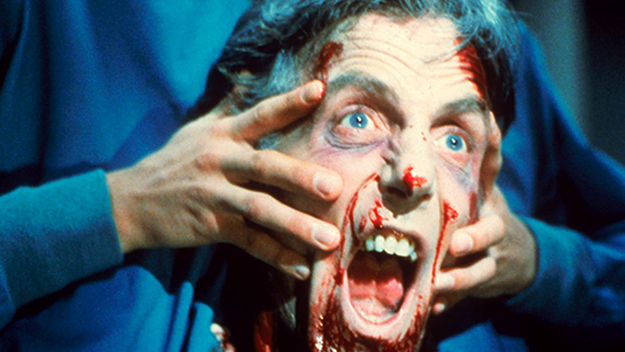
Re-Animator (Stuart Gordon, 1985)
After his success in the theater, Gordon made his first foray into film. Re-Animator, the story of a bizarre, anti-social medical student who resurrects corpses with a glowing green liquid, found an audience with gorehounds and film intelligentsia alike. Pauline Kael celebrated the ghastly comic excesses of Re-Animator in The New Yorker, writing of Gordon’s splatter-comedy, “the bloodier it gets, the funnier it is.” But along with the fountains of blood and inventive gore, Gordon’s expert work with actors was also attention-grabbing.
Barbara Crampton, who co-starred with Combs in Re-Animator, would go on to star in four of Gordon’s films, as would Combs. “He was precise in what he wanted you to do, always prodding you to explore a little deeper what you were feeling,” Crampton said in an interview last Friday. “‘More’ was a word he used often—‘be more afraid,’ ‘scream a little more,’ ‘more crying.’ He encouraged me to work intensely and genuinely, and any good moments I may have had on film even in other works which are even remotely deep or real, I can say unequivocally are owed to him, pushing me in ways I might not push myself. He taught me to look deeper.”
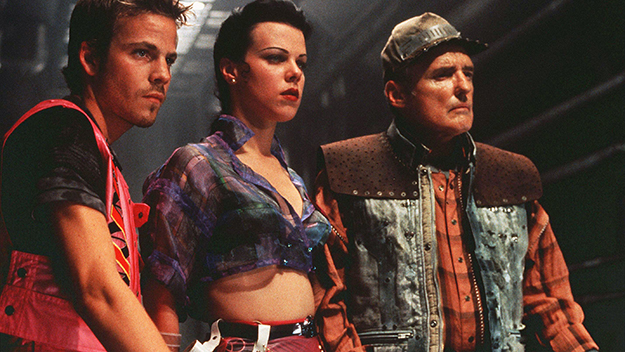
Stephen Dorff, Debi Mazar, and Dennis Hopper in Space Truckers (Stuart Gordon, 1997)
Crampton and Combs worked with Gordon again for his next, and perhaps headiest film, From Beyond (1986), the story of scientists who, in the course of their experiments, come under the sway of beings from another dimension. Based on a Lovecraft short story, Gordon’s second feature seethes with even more erotic energy than Re-Animator. The undulating visual effects become untethered from any material reality, and the result is body horror at its most fantastical and far-reaching in its implications.
A far cry from the ethereal weirdness of From Beyond, the 1995 film Castle Freak confronts horror at its most emotionally raw. Combs and Crampton play a couple who inherit a castle with a murderous, feral creature lurking inside. At the heart of the film, though, is the story of a family dealing with the death of a child. Combs is devastating as the self-destructive, alcoholic father tearing them apart. “He always pushed,” Combs said of Gordon’s direction. “Actors don’t want to be thought of as being over the top, but over the top was just fine with Stu.”
Combs’s ability to bring a boyish comedy to the most perverse of on-screen circumstances made him the perfect leading man for Gordon. Like Gordon’s films, he was simultaneously appealing and repulsive—part Jack Lemmon, part Boris Karloff. Combs remembers Gordon’s particular affinity for actors: “He loved actors. I worked with a lot of directors who are like ‘just hit your mark.’ Stuart was like, ‘Let’s go out and do something. Let’s work.’ He loved the life that actors exuded.”
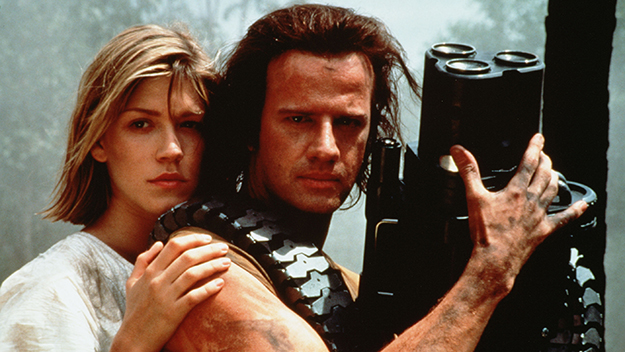
Fortress (Stuart Gordon, 1992)
Throughout the late ’80s and early ’90s Gordon would work outside the horror genre, most notably co-writing the story for the 1989 Disney film, Honey, I Shrunk the Kids. As director, his work explored new territory as well. Fortress (1992) depicts a bleak, totalitarian near-future, in which couples with more than one child are thrown into a nightmarish techno-prison. In Robot Jox (1990), gigantic, fighting robots represent the world’s nations in combat. Gordon would also direct a version of Ray Bradbury’s magical fantasy, The Wonderful Ice Cream Suit (1998).
With the exception of the impressively mounted Lovecraft adaptation, Dagon (2001), the new millennium would bring some of Gordon’s boldest steps outside of the horror genre. Edmond (2005), starring William H. Macy, adapts Mamet’s 1982 play about a businessman who upends his life after visiting a fortune-teller, and Stuck (2007), Gordon’s final film, takes its inspiration from a true story of a man left to die in the windshield of a car by the driver who hits him.
Gordon’s film work has earned him a spot among the ranks of masters of horror, but like the best of his contemporaries—Carpenter, Dante, Argento—the category feels narrow for what the director brought to the screen. His films presented a uniquely potent cinematic id, replete with oozing slime, blood, sex, and death—things we secretly long to touch, taste, or know about, but don’t dare. What made Gordon’s films unique and troubling was their power to seduce as well as scare.
Chris Shields is a New York–based filmmaker and writer. He is a frequent contributor to Art & Antiques magazine and Screen Slate.



